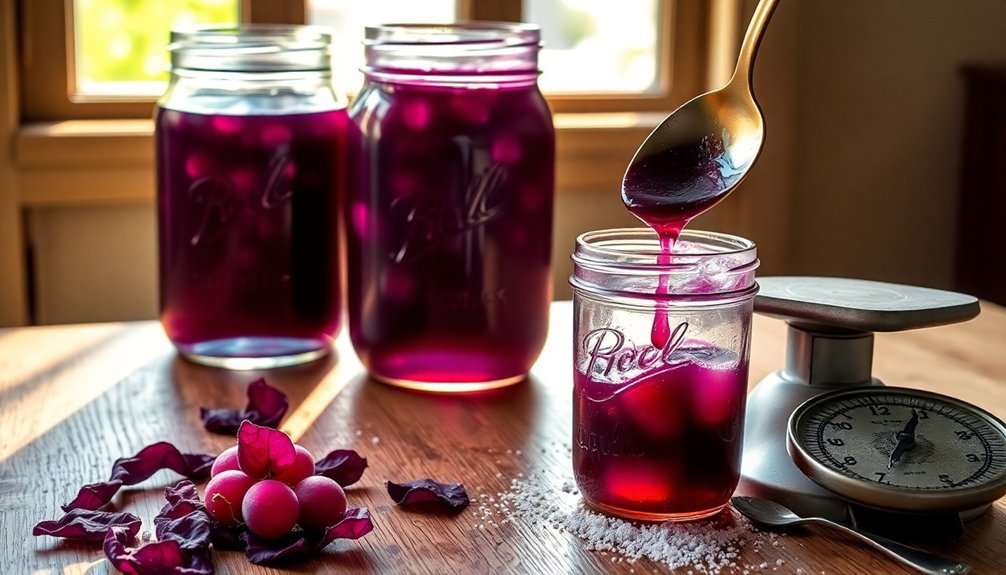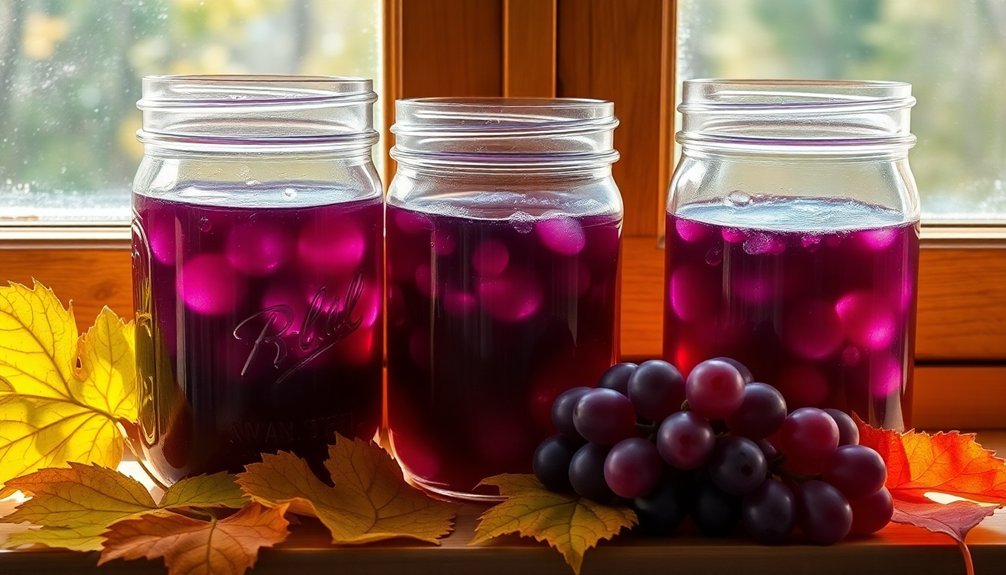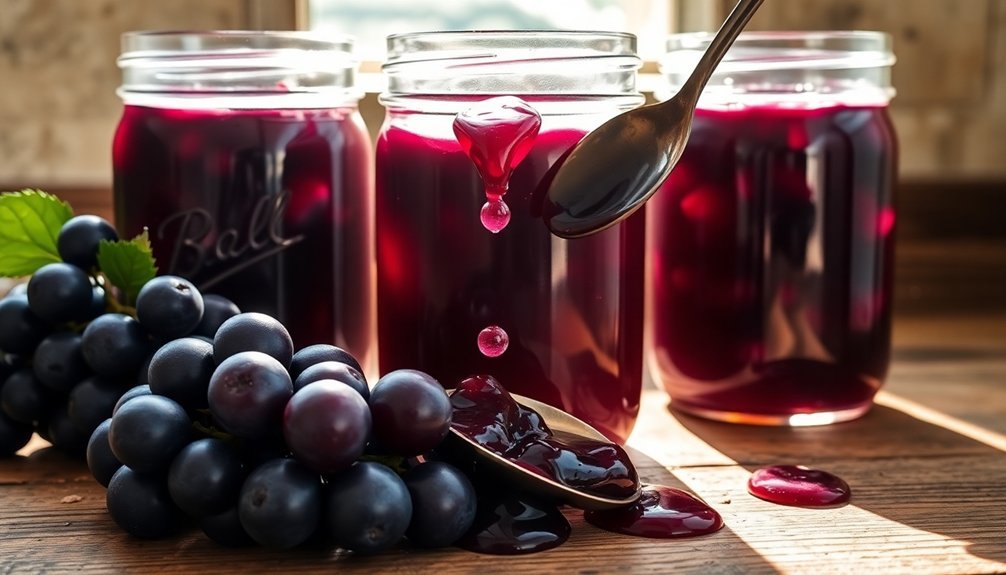You'll find three distinct grape jelly recipes perfect for your canning adventures: classic, low-sugar, and wild grape varieties. The traditional method uses 5 pounds of grapes with 4-6 cups sugar, delivering that familiar sweet taste you love. For health-conscious canners, try the low-sugar version using just 1/2 to 2 cups sugar while maintaining great flavor with special pectin. Wild grape jelly offers a unique, tart twist using 3-4 pounds of foraged grapes and 4 cups sugar. Each recipe produces shelf-stable jars lasting 12-18 months when properly processed. Let's explore these time-tested methods to create your perfect batch of homemade grape jelly.
Classic Grape Jelly Recipe

A jar of homemade grape jelly brings the essence of summer to your breakfast table year-round. To create this classic recipe, you'll need 5 pounds of fresh grapes or 5 cups of natural grape juice, 4-6 cups of sugar, and 1-2 boxes of pectin.
Concord grapes are traditionally preferred for their rich flavor and deep purple color. If you're starting with fresh grapes, crush them with a potato masher in a large bowl. Add just enough water to barely cover the fruit, then bring the mixture to a boil and simmer for 10 minutes.
Strain through a jelly strainer or cheesecloth, letting it drain overnight for best results. Let the juice stand for 12-24 hours to prevent tartrate crystals, then strain again.
Combine your strained juice with pectin and a small portion of sugar in a large saucepot. Bring to a boil while stirring constantly, then add the remaining sugar.
Return to a rolling boil for one minute, checking the temperature reaches 220°F. Skim off any foam that forms.
Pour the hot jelly into sterilized mason jars, leaving 1/4 inch headspace. Process in a water bath canner for 5 minutes at sea level.
Once sealed, your jelly will keep for 12-18 months.
Low Sugar Grape Jelly
Making low-sugar grape jelly lets you enjoy the natural sweetness of grapes while consuming half the sugar of traditional recipes. You'll need 4 cups of grape juice (either store-bought organic or fresh-pressed), 1/2 to 2 cups of sugar depending on desired sweetness, and 1 1/2 tablespoons of low-sugar pectin. Natural pectin found in grapes allows for a shorter cook time when using commercial pectin in low-sugar recipes.
| Component | Traditional vs. Low Sugar |
|---|---|
| Sugar Content | 50% reduction in sugar |
| Calories | 20-25 vs. 40-50 per serving |
| Pectin Type | Low-sugar specific pectin |
| Processing Time | 5 minutes in water bath |
| Shelf Life | Same as regular jelly |
Start by combining your grape juice with pectin and water. Bring the mixture to a rolling boil, then add your sugar and boil hard for one minute. Pour the hot jelly into sterilized jars, leaving 1/4 inch headspace. Process in a water bath canner for 5 minutes after the water starts boiling. Your finished jelly will maintain the rich grape flavor you love while containing just 4g of added sugars per serving. The recipe remains gluten-free and contains no artificial sweeteners, colors, or high fructose corn syrup.
Wild Grape Jelly Recipe

Wild grape jelly captures the intense, tangy flavor of foraged grapes in a way store-bought varieties can't match.
To start, you'll need 3-4 pounds of wild grapes to yield about 4 cups of juice. Cook the grapes with a small amount of water in a stock pot, then mash and strain them through a jelly bag or cheesecloth. Refrigerate the strained juice overnight to allow tartrate crystals to settle at the bottom.
Once you've got your juice, bring it to a boil in a saucepan. Add one box of powdered pectin and boil for a minute, stirring thoroughly.
Next, mix in 4 cups of sugar and return to a full rolling boil for another minute. You can test the consistency by dropping a small amount on a cool plate.
Pour the hot jelly into sterilized jars, leaving 1/4 inch headspace. Process the jars in a water bath canner for 10 minutes (15 minutes if you're above 6,000 feet elevation).
After processing, let the jars cool for 12-24 hours to guarantee proper sealing. Your properly sealed jars will keep for up to 18 months in the pantry.
If you skip the canning process, store your jelly in the refrigerator for up to two weeks or freeze it for six months.
Frequently Asked Questions
Why Did My Grape Jelly Turn Out Cloudy Instead of Clear?
Your grape jelly's cloudiness could be from squeezing the straining bag too hard, using under-ripe fruit, or waiting too long to fill jars. You've also might've used expired pectin or cooled the mixture too much.
Can I Use Frozen Grapes to Make Jelly?
Yes, you can use frozen grapes to make jelly. You'll need to thaw them first in a saucepan with a little water, then boil and strain them. Just know you'll get less juice than from fresh grapes.
What Causes Grape Jelly to Crystallize in the Jar?
Your grape jelly can crystallize if you've used too much sugar, haven't dissolved it properly, or failed to remove tartrate crystals. Improper cooking time, storage conditions, and temperature changes can also trigger crystallization.
Can I Double or Triple the Recipe for Larger Batches?
Yes, you can double or triple the recipe, but you'll need a large enough pot to handle the volume. Make certain to maintain constant stirring and follow proper ratios to guarantee successful jelling.
Why Does My Grape Jelly Taste Metallic?
If you're tasting a metallic flavor, it's likely from your pan's reaction with acidic grapes. Use a non-reactive stainless steel or enamel pot instead of aluminum or copper when cooking acidic foods.
In Summary
Now you're ready to enjoy homemade grape jelly year-round! Don't forget to properly store your sealed jars in a cool, dark place for up to 18 months. Whether you've chosen the classic recipe, low-sugar version, or foraged wild grapes, you'll taste the difference fresh ingredients make. Share your grape jelly with friends and family, or use it to create delicious PB&J sandwiches, pastries, and more.





Leave a Reply